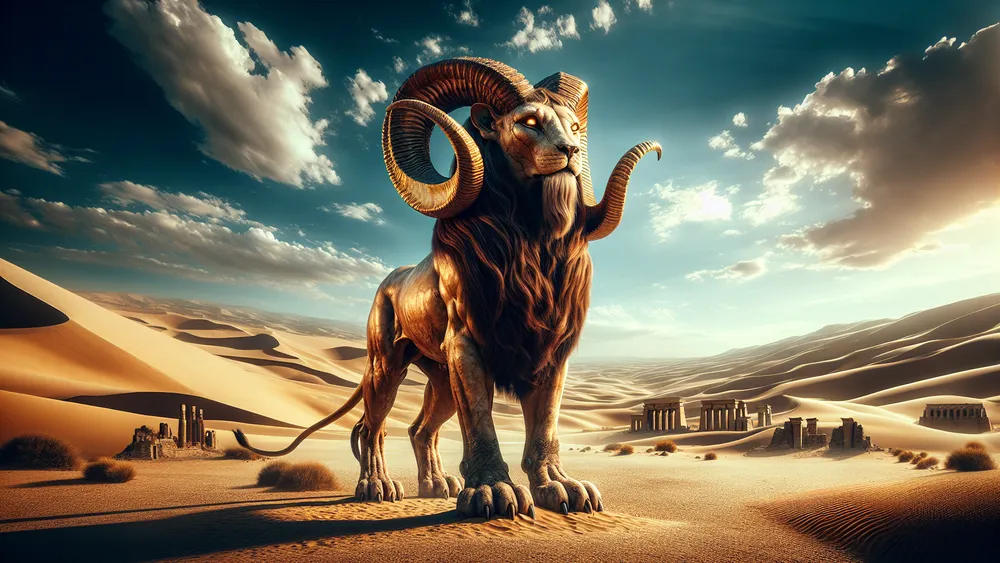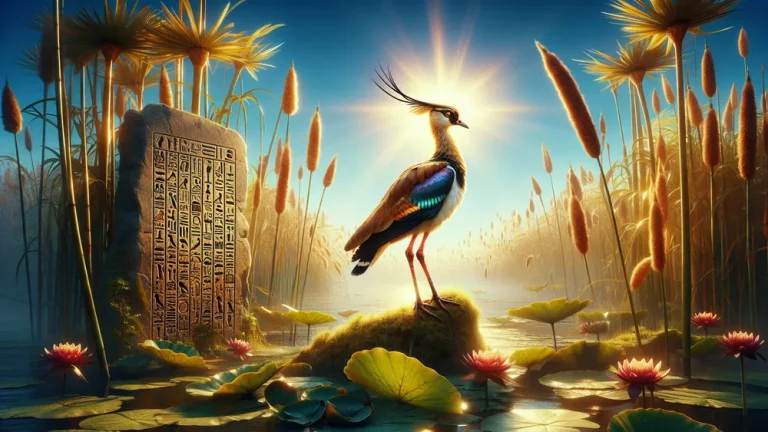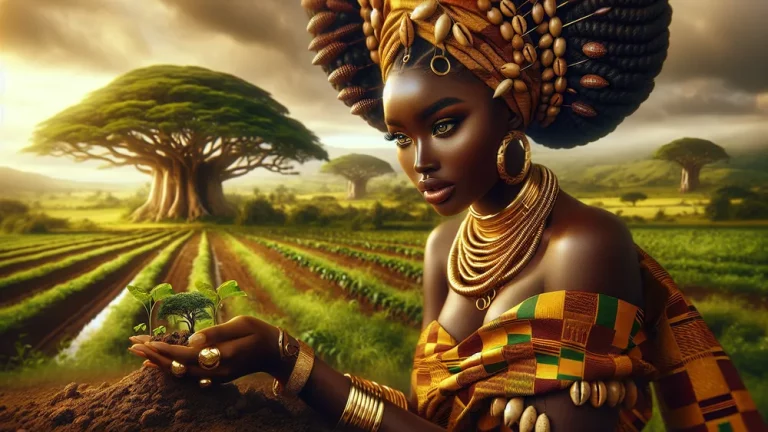Criosphinx: Ancient Egyptian Creature With Lion Body
Welcome to our look at the Criosphinx, an interesting creature from old Egyptian stories which has a lion’s body and a ram’s head. If you’re new to stories about gods, the Criosphinx is like the Greek Sphinx’s cousin, but it has its own unique points and importance.
Key Points:
- Criosphinx is an ancient Egyptian creature with a lion’s body and a ram’s head.
- It symbolizes strength, protection, and fertility in ancient Egyptian culture.
- Criosphinx is linked to the god Amon-Ra and was used in special places and buildings.
- The creature emerged during the New Kingdom period of old Egypt, around 1550-1070 BCE.
- Criosphinx statues were found in the Karnak Temple Complex, signifying its importance in religious practices.
- Criosphinx is different from other sphinx types like Androsphinx and Hieracosphinx due to its ram head.
- In modern times, Criosphinx is featured in various media and artworks, keeping its story alive.
In this post, we will go over the beginning and main points about the Criosphinx, its past details, and its role in old Egyptian life. We’re also going to compare it to other kinds of sphinxes and made-up beings, and look at how it is shown in art and buildings.
By the end of this journey, you will understand the Criosphinx well and know its place in old and new contexts. So, let’s start this trip through old stories together!
Criosphinx: Overview and Key Facts
| Key Point | Description |
|---|---|
| Definition | The Criosphinx is a made-up creature from old Egyptian stories, having a body of a lion and a head of a ram. |
| Origins | The Criosphinx started in old Egyptian times and is often used for the god Amon-Ra. |
| Significance | In Egyptian times, the Criosphinx stands for strength, protection, and being able to have children. It was often used in special places and buildings. |
| Comparison to Other Sphinxes | And, unlike the Androsphinx (human head, lion body) and the Hieracosphinx (hawk head, lion body), the Criosphinx has a ram’s head, which makes it different. |
| Historical Emergence | The Criosphinx came out during the New Kingdom time of old Egypt, around 1550-1070 BCE. |
| Physical Characteristics | The Criosphinx has a body of a lion for power and being royal, and a head of a ram for being able to have children and the god Amon-Ra. |
| Symbolism | The Criosphinx is a sign of protection, being strong, and having children, often put at temple doors to keep safe places holy. |
| Archaeological Findings | Big Criosphinx statues were found in the Karnak Temple Complex, making them important in old Egyptian special religious actions. |
| Cultural Influence | The Criosphinx changed other cultures’ made-up creatures, including Greek stories, where similar mixed beings are found. |
| Modern Depictions | Now, the Criosphinx can be seen in many kinds of media, like books, movies, and video games, and still amazes people all over the world. |
Getting to Know the Criosphinx
Since we already have a basic look and important points regarding the Criosphinx, now we will look closer at this interesting creature in more parts. Next, we will understand more details.
What Exactly is a Criosphinx?
The Criosphinx is a made-up creature from old Egyptian stories, having a lion’s body and a ram’s head. Starting during the New Kingdom time of old Egypt, about 1550-1070 BCE, the Criosphinx is often linked with the god Amon-Ra, who was shown with a ram’s head. This creature has the traits of both the lion and the ram, meaning a mix of strength, safety, and the ability to have children.
The lion’s body stands for power and being royal, while the ram’s head means being able to have children and the god connection to Amon-Ra. In old Egyptian times, the Criosphinx was more than just a made-up figure. It was an important sign put in special actions and temple buildings.
To know the Criosphinx more, you need to look at other kinds of sphinxes. The Androsphinx, like, has a human head and a lion’s body, meaning wisdom and strength. The Hieracosphinx, though, has a hawk’s head and a lion’s body, standing for the sky and gods. But the Criosphinx’s ram head makes it different, showing its connection with being able to have children and the god Amon-Ra. Here’s a quick look to show these differences:
- Androsphinx: Human head, lion body; stands for wisdom and strength.
- Hieracosphinx: Hawk head, lion body; means the sky and gods.
- Criosphinx: Ram head, lion body; shows strength, safety, and the ability to have children, and is linked to Amon-Ra.
By seeing these differences, you can know the special role the Criosphinx had in old Egyptian stories and culture.
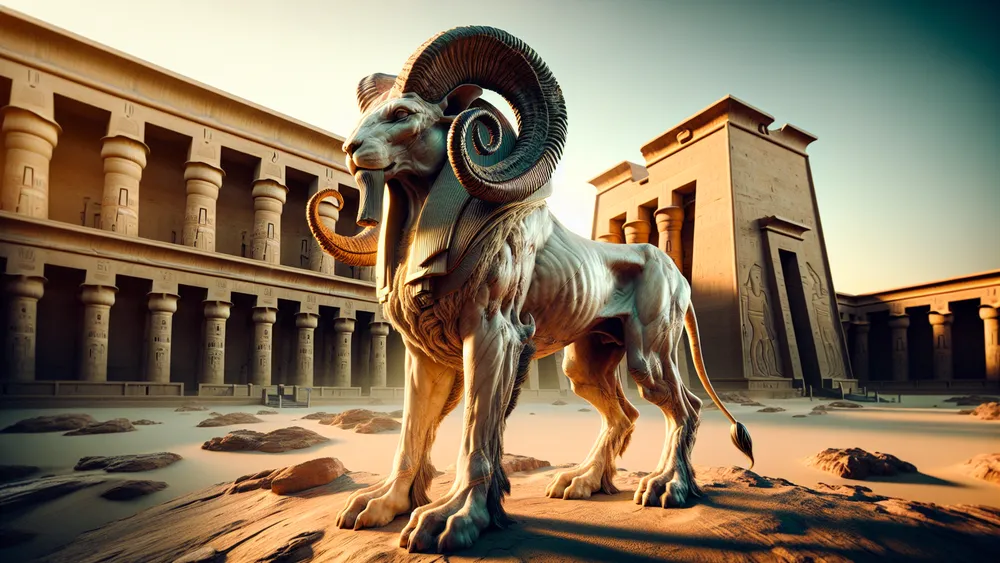
The Criosphinx in old Egyptian stories symbolizes strength, safety, and fertility due to its unique lion’s body and ram’s head, closely tied to the god Amon-Ra.
Historical Background and Looks
The Criosphinx started in the New Kingdom time period of old Egypt, which was from about 1550 to 1070 BCE. This time had a big growth of art, culture, and religion, with a focus on worshiping Amon-Ra, the sun god. And, the Criosphinx, with its special mix of a lion’s body and a ram’s head, became an important sign during this time.
The lion’s body showed power and being royal, while the ram’s head was linked directly with Amon-Ra, who had ram horns often. This mix made the Criosphinx a strong sign of godly strength and safety. Physically, the Criosphinx is a noticeable creature.
Think of a strong lion, known for its power and royal look, but with a head of a ram, an animal often tied with having children and the god Amon-Ra. The lion’s body stands for power and rule, things highly important in old Egyptian times. The ram’s head, also, means having children and a godly link, especially to Amon-Ra.
This special blend of parts made the Criosphinx a strong sign in old Egyptian culture, having both earth and god-like traits.
The many meanings tied with the Criosphinx are detailed. It was seen as a keeper, giving protection to holy areas like temples. Its strength and power were thought to keep evil away and make safe those in its care. Famous finds, such as Criosphinx statues in the Karnak Temple Complex, give helpful looks into its importance.
These statues, put at temple entrances often, show the role of the Criosphinx as a keeper and a sign of godly strength. To know the Criosphinx better among other made-up creatures, look at this comparison:
| Mythical Creature | Physical Traits | Symbolism |
|---|---|---|
| Criosphinx | Lion body, ram head | Strength, safety, having children, linked with Amon-Ra |
| Androsphinx | Lion body, human head | Wisdom, strength |
| Hieracosphinx | Lion body, hawk head | Sky, god link |
| Greek Sphinx | Lion body, human head, wings | Mystery, riddles, keeping places |
This table helps to show the special traits and meanings of the Criosphinx compared to other made-up creatures, showing its special place in old Egyptian stories.
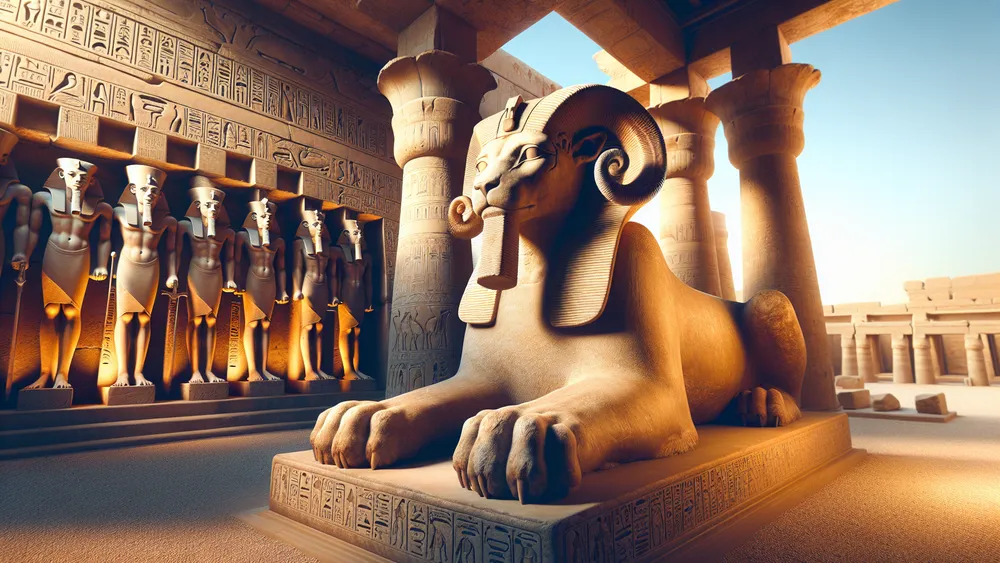
The Criosphinx, with its unique lion body and ram head, symbolized strength, safety, having children, and a strong connection to the god Amon-Ra in ancient Egyptian culture.
The Criosphinx in Ancient Egyptian Life
Now that we know about the historical background and looks of the Criosphinx, we should check out its role and importance in old Egyptian life. Next, see what part it played back then.
Importance in Religion, Myths, and Stories
The Criosphinx played an important role in old Egyptian religious activities and made-up stories. As a watcher, it was often put at the temple entrances to keep holy spaces safe from bad forces. The showing of Criosphinx statues in templar buildings, like those found in the Karnak Temple Complex, shows its importance in holy actions.
And these statues were not just for looks but were strong signs of godly safety and power, having the traits of both the lion and the ram. During holy events, the Criosphinx was called on to keep the safety of the events and the people. The Criosphinx is linked with the god Amon-Ra, one of the big gods in old Egyptian religion.
Amon-Ra, often shown with a ram’s head, was the god of the sun and making things, having big power and the ability to give life. The Criosphinx, having a ram head, was seen as showing Amon-Ra’s godly traits on earth. And this link made the Criosphinx a key piece in worshiping Amon-Ra since it showed the god’s safety and life-giving traits.
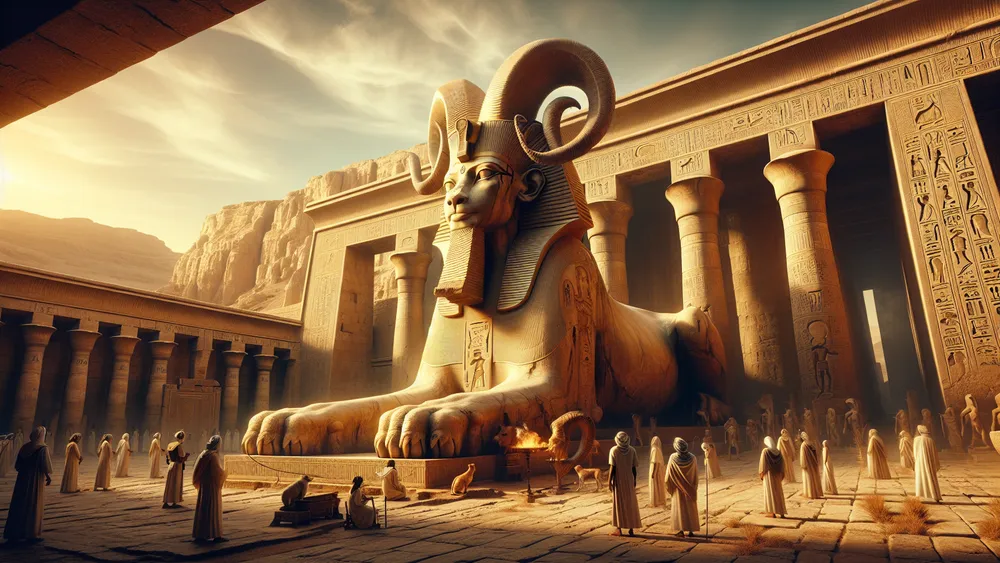
Temples built for Amon-Ra had Criosphinx statues a lot, showing the link between the god and this made-up creature. Images of the Criosphinx can be found in many old Egyptian writings and books, where it is often described as a strong watcher and keeper.
Though stories with the Criosphinx are less common than those with other made-up creatures, its presence in holy writings shows its symbolic importance. If you compare it to other cultures, like the Greeks, who showed their sphinxes as riddle-makers and keepers of wisdom, the Egyptian Criosphinx was more about guarding and being linked to gods.
This shows the special role the Criosphinx had in old Egyptian stories, highlighting its god connections and job as a keeper of holy places.
Shown in Art and Buildings
The Criosphinx was a well-known shape in old Egyptian art, often shown in statues, engravings, and pictures. Artists of the time put together the strong form of a lion with the unique head of a ram, making a creature that combined both strength and godly protection. But, these art pieces were not just for looks but to show the symbolic meaning of the Criosphinx.
So, for example, engravings of the Criosphinx can be found on shrine walls, where they were thought to offer safety and call upon the existence of the god Amon-Ra. The detailed work in these art pieces shows how important the Criosphinx was in old Egyptian ways and religion. Criosphinx statues were usually put in shrines and other big buildings, acting as watchers of holy spaces.
And one of the best examples is the road of Criosphinxes at the Karnak Shrine Complex in Luxor. This large road, lined with statues of the Criosphinx, leads to the shrine of Amon-Ra, showing the creature’s link to this powerful god. However, these statues were purposely put to protect the shrine and its visitors, showing the godly strength and safety of Amon-Ra.
The historical importance of these statues is huge, as they give a good look into the religious practices and building works of old Egypt. By looking into these art pieces, we get a better understanding of the cultural and spiritual importance of the Criosphinx in old Egyptian society.
The Criosphinx Around the World
Now that we have looked at the Criosphinx’s importance in old Egyptian art and buildings, we should now see how this made-up thing looks at other sphinx kinds and its effect on world legend. Next, let’s check how it all goes together.
Comparing Different Sphinx Types
The Criosphinx, which has a body like a lion and a head like a ram, looks different from other kinds of sphinxes like the Greek Sphinx and the Hieracosphinx. For instance, the Greek Sphinx usually shows a lion’s body, a woman’s head, and bird’s wings.
This mix of traits means secrets, smartness, and the power to guard holy knowledge, such as in the tale of Oedipus where the Greek Sphinx gives a riddle to those passing by. The Hieracosphinx, another Egyptian type, has a lion’s body and a falcon’s head, showing the god Horus. This type focuses on sharp eyesight and godly kingship traits.
And while all these sphinxes have a lion’s body in common, their different heads and what they mean show the unique cultural backgrounds they come from. These sphinx types have differences and similarities that go beyond just their looks to what they mean. The Criosphinx, linked with Amon-Ra, means safety, strength, and the ability to give life, showing the god’s features.
On the other hand, the Greek Sphinx’s meaning revolves around smartness and puzzles, often acting as a keeper of holy or hidden knowledge. The Hieracosphinx, connected to Horus, shows godly kingship and safety. And the swapping of cultural and mythological ideas between old Egypt and Greece probably affected these shows.
For example, the idea of a keeper creature with a lion’s body might have moved from Egypt to Greece, where it was changed to fit Greek myth ideas. This sharing of ideas shows the connectedness of old civilizations and their shared interest in mythical keepers.
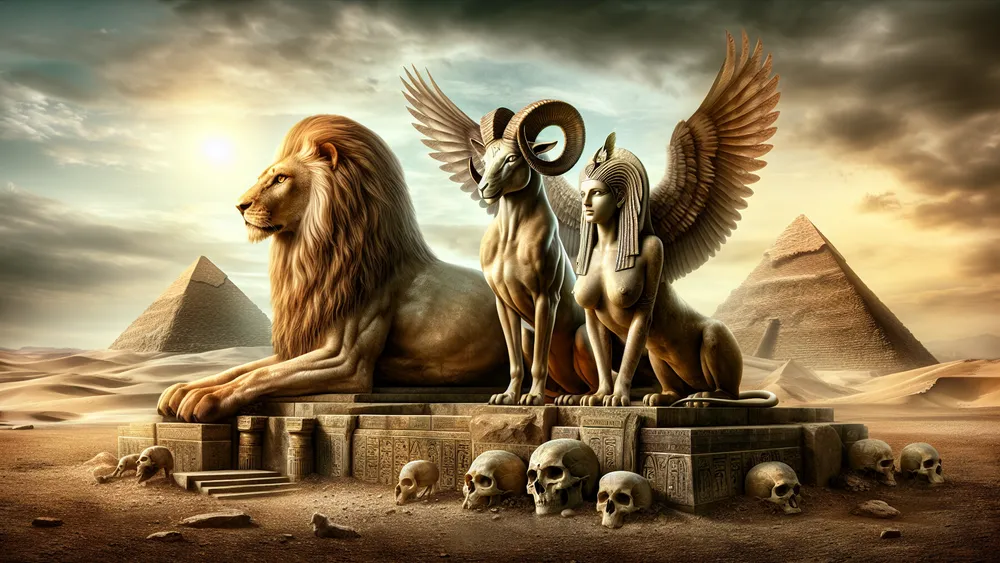
Today’s Take on the Criosphinx
The Criosphinx shows up in different forms in today’s media, such as books, films, and games. For instance, in the world of games, the Criosphinx is in “Assassin’s Creed Origins.” It shows as a protector of old secrets, reflecting its old role in Egyptian stories. In books, the Criosphinx often appears in fantasy stories that use old myths to create engaging worlds.
These modern shows often stress the creature’s secret and protective traits, changing its old meaning for today’s viewers. Using the Criosphinx in popular media, creators keep the story alive, allowing new generations to connect with this interesting creature. And the effect of the Criosphinx goes beyond media into today’s art and popular culture.
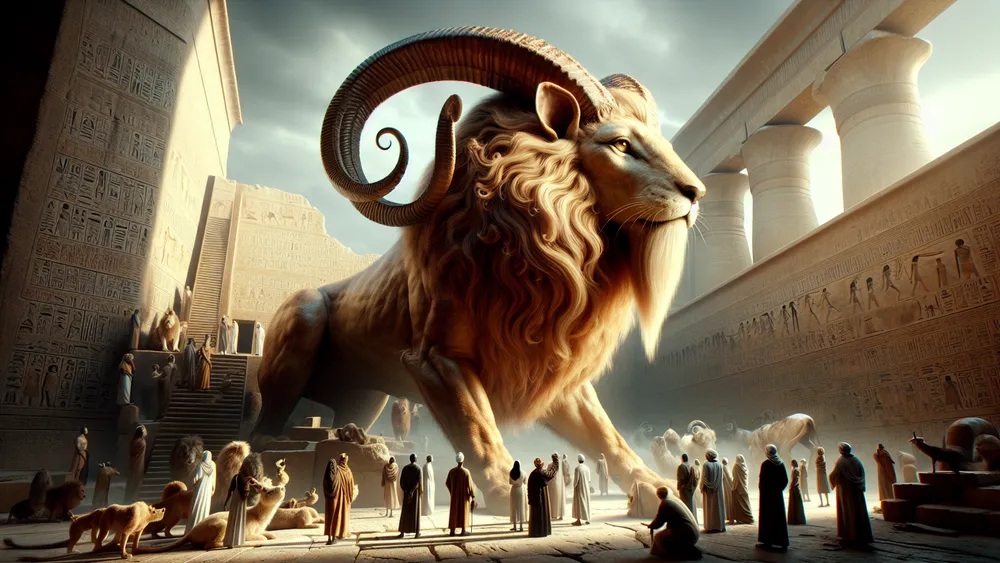
Today’s artists and sculptors have looked at the Criosphinx for ideas, making works that respect its old roots while adding a new style. Museum shows often have copies or new versions of Criosphinx statues, showing their historical and cultural importance.
Moreover, new digs and studies continue to give more details on the Criosphinx. For example, new finds at dig sites in Egypt have given more details about the role and meaning of the Criosphinx in old times.
These finds not only increase our understanding of the Criosphinx but also spark new interest in its tale, making sure this mythical creature stays a relevant and interesting subject in both academic and popular spaces.
Pantheon of Egyptian Mythical Creatures
The Criosphinx is just one interesting member of the big group of Egyptian made-up creatures. And the old Egyptian stories are filled with different interesting beings, each with its own unique traits and meanings. The Bennu bird that is protective and wise, or the Apep serpent which is scary and wild. Moreover, these creatures had important roles in the religious and cultural life of old Egypt.
For instance, each creature had a specific role and meaning. To check out the full range of these made-up beings, you can look at this list of all the Egyptian creatures, which gives detailed write-ups and insights into their tales and importance.
FAQs
1. What makes the Criosphinx different from other types of sphinxes?
What makes the Criosphinx different from other types of sphinxes is its unique combination of a lion’s body and a ram’s head, symbolizing strength and fertility in ancient Egyptian culture.
2. Where have Criosphinxes been found in ancient Egyptian architecture?
Criosphinxes have been found in ancient Egyptian architecture primarily at temple complexes such as Karnak and Luxor.
3. How has our idea of the Criosphinx changed in modern times?
Our idea of the Criosphinx has changed in modern times by evolving from a religious symbol to a subject of artistic and popular culture interpretations.
4. Are there any specific myths or legends about the Criosphinx?
Specific myths or legends about the Criosphinx are relatively scarce, but it is often associated with the god Amon-Ra in ancient Egyptian mythology.

